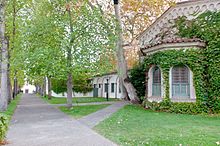
The Old Dominion Athletic Conference (ODAC) is an NCAA Division III athletic conference. Of its 15 member schools, all but one are located in Virginia; the other full member is in North Carolina. The conference also has two associate members: one in Virginia and one in North Carolina.

Mixed-sex education, also known as mixed-gender education, co-education, or coeducation, is a system of education where males and females are educated together. Whereas single-sex education was more common up to the 19th century, mixed-sex education has since become standard in many cultures, particularly in Western countries. Single-sex education remains prevalent in many Muslim countries. The relative merits of both systems have been the subject of debate.

Mary Mason Lyon was an American pioneer in women's education. She established the Wheaton Female Seminary in Norton, Massachusetts, in 1834. She then established Mount Holyoke Female Seminary in South Hadley, Massachusetts, in 1837 and served as its first president for 12 years. Lyon's vision fused intellectual challenge and moral purpose. She valued socioeconomic diversity and endeavored to make the seminary affordable for students of modest means.

The University of Roehampton, London, formerly Roehampton Institute of Higher Education, is a public university in the United Kingdom, situated on three major sites in Roehampton, in the London Borough of Wandsworth. The University traces its roots to four institutions founded in the 19th century, which today make up the university's constituent colleges, around which student accommodation is centred: Digby Stuart College, Froebel College, Southlands College and Whitelands College.

Mary Baldwin University is a private university in Staunton, Virginia. It was founded in 1842 as Augusta Female Seminary. Today, Mary Baldwin University is home to the Mary Baldwin College for Women, a residential women's college with a focus on liberal arts and leadership, as well as co-educational residential undergraduate programs within its University College structure. MBU also offers co-educational graduate degrees as well as undergraduate degree and certificate programs for non-traditional-aged students.
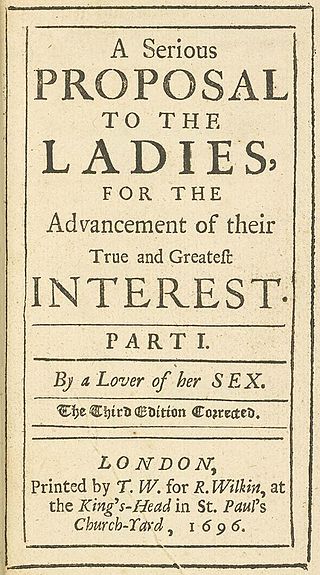
Mary Astell was an English protofeminist writer, philosopher, and rhetorician who advocated for equal educational opportunities for women. Astell is primarily remembered as one of England's inaugural advocates for women's rights and some commentators consider her to have been "the first English feminist."

Sweet Briar College is a private women's liberal arts college in Sweet Briar, Amherst County, Virginia. It was established in 1901 by Indiana Fletcher Williams in memory of her deceased daughter, Daisy. The college formally opened its doors in 1906 and granted the B.A. degree for the first time in 1910. It nearly closed in 2015 but was saved by donations and legal actions by alumnae.

Pakistan Adventist Seminary & College is a Christian co-educational institution of higher learning located in the Punjab province of Pakistan. The purpose of the Pakistan Adventist Seminary is to train workers to serve the church in Pakistan and beyond, as well as to prepare Christian youth for useful service to society.
Froebel College is one of the four constituent colleges of the University of Roehampton.
The following is a timeline of women's colleges in the United States. These are institutions of higher education in the United States whose student population comprises exclusively, or almost exclusively, women. They are often liberal arts colleges. There are approximately 35 active women's colleges in the U.S. as of 2021.
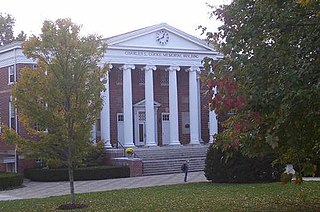
Women's colleges in the Southern United States refers to undergraduate, bachelor's degree–granting institutions, often liberal arts colleges, whose student populations consist exclusively or almost exclusively of women, located in the Southern United States. Many started first as girls' seminaries or academies. Salem College is the oldest female educational institution in the South and Wesleyan College is the first that was established specifically as a college for women, closely followed by Judson College in 1838. Some schools, such as Salem College, offer coeducational courses at the graduate level.
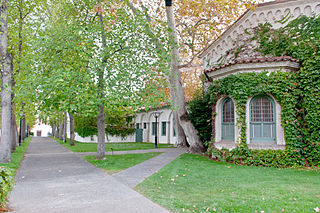
Women's colleges in the United States are private single-sex U.S. institutions of higher education that only admit female students. They are often liberal arts colleges. There were approximately 26 active women's colleges in the United States in 2023, down from a peak of 281 such colleges in the 1960s.
In the early colonial history of the United States, higher education was designed for men only. Since the 1800s, women's positions and opportunities in the educational sphere have increased. Since the late 1970s and early 1980s, women have surpassed men in number of bachelor's degrees and master's degrees conferred annually in the United States and women have continuously been the growing majority ever since, with men comprising a continuously lower minority in earning either degree. The same asymmetry has occurred with Doctorate degrees since 2005 with women being the continuously growing majority and men a continuously lower minority.
Briar Cliff University is a private Franciscan university in Sioux City, Iowa.
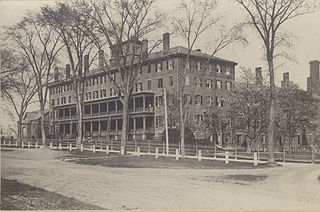
A female seminary is a private educational institution for women, popular especially in the United States in the nineteenth and early twentieth centuries, when opportunities in educational institutions for women were scarce. The movement was a significant part of a remarkable transformation in American education in the period 1820–1850. Supporting academic education for women, the seminaries were part of a large and growing trend toward women's 'equality'. Some trace its roots to 1815, and characterize it as at the confluence of various liberation movements. Some of the seminaries gradually developed as four-year colleges.
London Universities and Colleges Athletics (LUCA) is the representative and governing body for university athletics in London.
A finishing school focuses on teaching young women social graces and upper-class cultural rites as a preparation for entry into society. The name reflects the fact that it follows ordinary school and is intended to complete a young woman's education by providing classes primarily on deportment, etiquette, and other non-academic subjects. The school may offer an intensive course, or a one-year programme. In the United States, a finishing school is sometimes called a charm school.
Rachel Scott, born Rachel Cook, was a British women's education reformer, based in Manchester, who organised and promoted equality for women.
